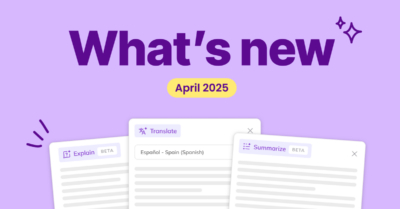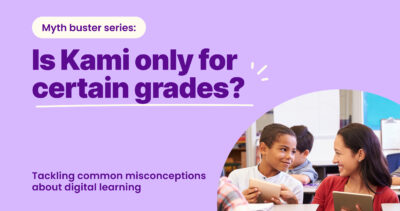Shirin Bradfield
Now that you know what UDL is from reading our other blogs, What is UDL and Examples of UDL, you must be itching to implement it into your learning environment.
The first thing to remember is that Universal Design for Learning is a broad category. The official Universal Design for Learning guidelines says it encompasses multiple means of engagement, assistive technologies, goal-directed lesson plans, and interactive curriculum development to present information in order to optimize student learning. But, what does all that actually mean?
The following blog is about the three fundamental UDL principles that you can begin to introduce to your classroom. You can adopt these into your lesson planning and instructional design. Or you could simply have a read-through and add these instructional materials to your teaching toolbox.
The principles of UDL are an effective network that focuses on providing multiple means for learners. The UDL framework is a way of providing multiple paths for learners to arrive at the same goal, regardless of impairments, disabilities, or other factors that can be limiting under more regimented and inflexible learning environments. Whether you teach special education or not, these principles provide a great set of checkpoints to introduce to your lesson plans.
The three principles of UDL are:
- Multiple Means of Representation
- Multiple Means of Action and Expression
- Multiple Means of Engagement
As we mentioned in our previous blog, What is UDL?, UDL comes in many different formats. Think of the different ways in which teachers present information to their learners. When you set a task for the class, chances are that you will say the instruction out loud as well as write it up on your whiteboard or smart board. This basic, almost instinctive method is already a part of most teachers’ instructional design. Universal Design for Learning recognizes these multiple means of presenting information as multiple means of action, which is one of the guiding principles of UDL. See? You’re already partway there! These guidelines are a result of an ongoing collaboration with the National Center for the Application of Applied Special Technology, (CAST). Located near Boston, CAST is a nonprofit education research and development organization that created the UDL framework and UDL Guidelines. You can see more of their projects here!
Multiple means of representation
As with most lesson plans, giving your learners an opportunity to demonstrate their background knowledge can be a good way to start a new topic or to revisit an old one. This is what this principle focuses on. The multiple means of representation principle encourages educators to present information in a variety of formats. The same concept could take the form of text, images, graphic organizers, video, audio, or practical activities. Learners benefit from the variability of assistive technologies that facilitate learning, such as screen readers, automatic fliers, voice recognition programs, or closed captions.
It is crucial to make information available in multiple formats because learners differ in their perception and understanding of the concepts presented to them. Using a checklist can be really helpful in making sure all your learners’ needs are met for each lesson.
Learners with impairments may not benefit from a one-size-fits-all approach to content and may require different formats to meet their needs. At the same time, there may be others who simply understand certain information more efficiently by audio or visual means than by printed text.
Multiple representations of a concept are also known as “dual coding”. It facilitates learning by enabling students to see the links within individual concepts and between different concepts. So by hearing and seeing a concept explained, they can make their own connections to it.
Multiple means of action and expression
The second principle focuses on action and expression, which is essential. Teachers must provide a range of ways for students to express their knowledge by offering them the most interesting means, such as writing an essay on a theme or story or creating a video, etc.
This principle assists educators in providing students with a variety of ways to demonstrate what they have learned. Learners differ in the manner in which they navigate learning environments and demonstrate what they know. For example, learners with significant locomotor impairments, such as cerebral palsy or muscular dystrophy, and those facing language barriers may have different approaches to learning tasks. They may prefer to express their knowledge through a written text, an oral or visual presentation, or a group assignment/project.
Multiple means of engagement
The third principle encourages teachers to use different methodologies to address the variability of their students’ learning needs. Some of the factors that influence individual change in motivation include culture, neurology, personal relevance, and previous knowledge. For example, dyslexic learners are generally able to understand concepts more quickly learning through experience than through the use of printed text. These students may be motivated to learn if the concepts are taught through activities that use kinesthetic skills, such as acting or role-playing. Not only does this benefit dyslexic learners, but learning through physical action is a great way of recruiting interest in younger or difficult learners.
A great way to introduce multiple means of engagement into your classroom is to create opportunities for learners to provide their input on how classroom tasks are designed. This style of recruiting interest helps develop a strong effective network in your learning environment.
Multiple means of engagement can help different groups of learners in different ways without watering down learning outcomes. Not every strategy will work in every classroom, or for every subject area—find the ones that you are comfortable with and that work for your discipline and learners.
These principles can be applied to the overall design of a course and instructional strategies and materials to be used to teach a course. UDL principles can also incorporate these principles into presentations, group work, learning activities, fieldwork, discussions, and demonstrations to make learning more accessible and efficient for all learners. These principles aren’t just reserved for higher education, you can introduce UDL principles at any level!
These UDL principles are all super-easy to introduce into your learning environment. Keeping these in mind during your curriculum development will go a long way in meeting the various learning needs that your students have. Students with diverse learning experiences will come away with more variability in their problem-solving approaches. The more learning opportunities you can provide, the more naturally that recruiting interest will come; Remember, Multiple Means is the name of the game!
You may also like

Unlocking understanding: Kami’s latest updates designed for every learner

The state of SPED and ELL technology in 2025

